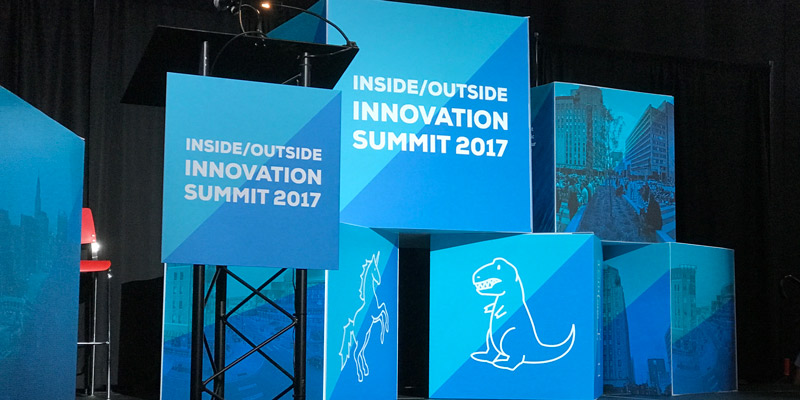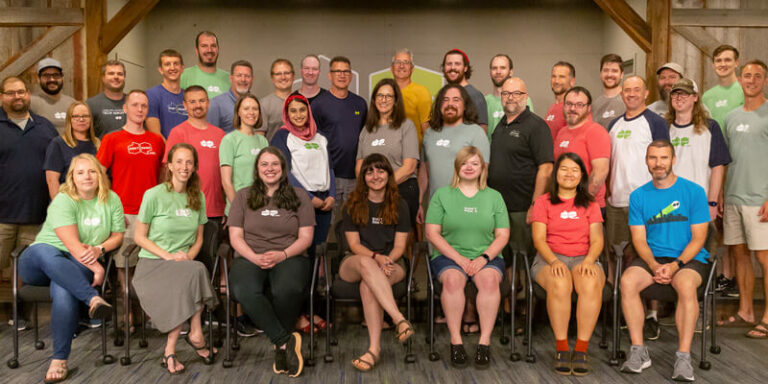
Reflecting on the First Inside/Outside Innovation Summit
Last week, entrepreneurs, business owners, startups, and corporate innovators experienced the first Inside/Outside Innovation Summit at Pinnacle Bank Arena. The event was put on by the team at Econic (especially Brian Ardinger and Josh Berry) with the mission to bring together startups and corporate innovators.
A few of members of our team were on hand to meet with the startups presenting on the showcase floor, learn from the great speakers brought in from around the world, and simply witness some of the great work happening here in Nebraska.
We all walked away absolutely impressed with the unique conference experience mixing startups and corporations. Beyond the experience itself, we frequently found ourselves torn between hearing the compelling content and sessions and continuing the ad-hoc hallway conversations with fascinating innovators.
At the conclusion of the summit (which ended with Lincoln-based CompanyCam winning the $100k pitch competition sponsored by Nelnet), I felt as if we witness something really special. I surveyed our team who attended to get their thoughts.
Bill Udell
I was really intrigued by a practice at Pivotal Labs to do Pair “Programming” with their product owners. This really got my wheels turning on so many issues I’ve seen frequently over the years. The product owner seems to always be the person left on an island to balance nearly unmanageable competing forces. Pairing that role doesn’t make the number of competing forces any fewer, but worst case provides a bobble head for talking through the backlog. This is something I want to start experimenting with ASAP at Don’t Panic Labs.
I also really enjoyed Simone Ahuja from Blood Orange. Her self-identification and description of how to spot an intrepreneur made me long for a Harry Potter “Sorting Hat”. The quote of “14% of college graduates want to work at a large company” was maybe my favorite quote of the conference. The obvious take away is that people don’t want to work for a big company. The not-so-obvious thing that continues to rattle around my head is that WAY more than 14% of college grads ARE in large companies. So what does that mean about the happiness of those employees… the quality of the work produced… the happiness of their customers? It seems to me that big companies are teetering on a really precarious ledge here. The world, nation, midwest, and Lincoln need companies of all sizes to thrive. How can we help the big company change its ways? There are definitely things we have learned about software engineering that could probably make things a lot more fun.
Lori McCarthy
I noted a simple but important takeaway from Simone Ahuja’s talk ‘Disrupt-It-Yourself: How Corporations Can Help Intrapreneurs Be Fast, Fluid and Frugal’: Managers need to support intrapreneurs to release their passion and purpose.
During Mickey Cloud’s talk ‘Capturing Consumer Attention in an Ever-Fragmented Media Landscape’, I learned that when selecting where to promote your product or service, you should try to select media that is under-priced for the impressions it produces. I thought it was especially interesting to learn that drive-time radio may be quite under-priced based on the fact that buying of radio time is decreasing compared with the reality that drive-time radio listenership has actually stayed pretty consistent.
I also appreciated the reminder that although content on Facebook and Instagram is a current effective way to market, the next wave of marketing is going to be in AI, VR and Internet of Things.
While sitting at a round table discussion on internet of things, I heard some interesting insights around the fact that many novel applications of IoT don’t have a market sizable enough to make them economically viable compared with the cost of research, development, production and testing. I also learned of the existence of special and/or upgraded cell networks which set aside a portion of the spectrum to enable IoT devices; TechCrunch provides a good overview.
Russ Guill
I have to admit that I sometimes have a tough time getting excited for conferences. Maybe it’s the curse of being so painfully introverted. However, I can’t get over how fired up the I/O Summit got me for the current state of corporate innovation (especially when I see what’s happening in our own backyard).
I got to connect with former coworkers doing great stuff at other companies and meet new folks who are part of local corporate innovation efforts.
And I also have to admit this was my first time hearing BuluBox co-founder Paul Jarrett speak. And it was doubly great when he broke the news during his talk that Bulu Marketplace had been acquired. Just another reason to #BangTheDrum about what’s going on here.
I’m already looking forward to next year.
A Few Last Thoughts
A whole range of tools, techniques, behaviors, and frameworks has popped up over the past few years to help innovators and entrepreneurs succeed. It can be tough to keep up, let alone realize the appropriate times and situations for each of the tools. Sugath Warnakulasuri of Thalamus Labs put together an amazing visual showing how all of these tools fit together. I’d highly recommend reaching out to him to obtain a copy.
We’ve all heard the stats on innovation portfolio management. About 50% of ventures fail early and fast. 40% limp along. 9% generate a return. And 1% is the unicorn that generates a big return. Tristan Kromer of Kromatic did more than just present the stats. He engaged the crowd by having them stand up, sit down, and even had the 40% act like zombies while helping people understand these dynamics.
Overall, this was a great conference. Brian, Josh, and the rest of the Econic team set the bar REALLY HIGH with their inaugural outing. We can’t wait to see what they have planned for next year.



